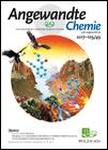版权所有:内蒙古大学图书馆 技术提供:维普资讯• 智图
内蒙古自治区呼和浩特市赛罕区大学西街235号 邮编: 010021

作者机构:State Key Laboratory of Fine Chemicals Frontiers Science Centre for Smart Materials Oriented Chemical Engineering School of Bioengineering Dalian University of Technology Dalian 116024 China Ningbo Institute of Dalian University of Technology Ningbo 315016 China Department of Mechanical Engineering Kennesaw State University GA 0060 Marietta USA Department of Biomedical Engineering Southern University of Science and Technology Shenzhen 518055 China National Energy Research Centre for Biorefinery Beijing University of Chemical Technology Beijing 100029 China School of Biomedical Engineering SUN YAT-SEN University Shenzhen 518000 China
出 版 物:《Angewandte Chemie》 (应用化学)
年 卷 期:2022年第134卷第52期
页 面:e202214001-e202214001页
学科分类:081704[工学-应用化学] 08[工学] 0817[工学-化学工程与技术]
主 题:Cascade Reactions Enzymes Protein Cages Self-Assembly
摘 要:Cells use self-assembled biomaterials such as lipid membranes or proteinaceous shells to coordinate thousands of reactions that simultaneously take place within crowded spaces. However, mimicking such spatial organization for synthetic applications in engineered systems remains a challenge, resulting in inferior catalytic efficiency. In this work, we show that protein cages as an ideal scaffold to organize enzymes to enhance cascade reactions both in vitro and in living cells. We demonstrate that not only enzyme-enzyme distance but also the improved K m value contribute to the enhanced reaction rate of cascade reactions. Three sequential enzymes for lycopene biosynthesis have been co-localized on the exterior of the engineered protein cages in Escherichia coli , leading to an 8.5-fold increase of lycopene production by streamlining metabolic flux towards its biosynthesis. This versatile system offers a powerful tool to achieve enzyme spatial organization for broad applications in biocatalysis.